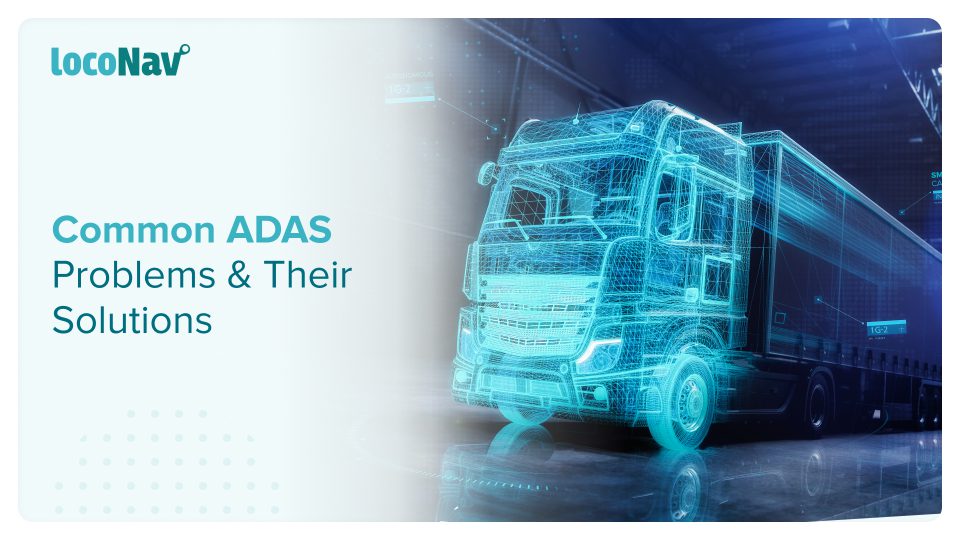

Advanced Driver Assistance Systems (ADAS) has been rapidly integrated into vehicles over the last ten years, with almost every new car now having level 1 or level 2 capability. Initially invented for vehicle safety, ADAS is now regarded as a critical enabler technology for Autonomous Vehicles (AV). ADAS technology is currently experiencing an industry-shifting upgrade on its general development and deployment process in the automotive space, with an evolving use case compounding the rapid adoption resulting in ADAS challenges.
Consumers and businesses alike are afflicted by ADAS challenges. While there are core ADAS features that can function similarly across OEMs, such as forward collision warning, lane keeping, or blind spot monitoring, each OEM puts its own spin on the different technologies and markets them under their own brand names.
Make your business more profitable with LocoNav’s Telematics
The following are some common ADAS challenges, as well as solutions to these ADAS challenges.
How is the Autonomous Industry Growing with ADAS Adoption?
It’s no secret that the race to driverless vehicles is on, and it’s changing the way people travel around the world. However, getting there is heavily reliant on two fundamental elements: widely spread adoption of advances in technology such as advanced driver assistance systems (ADAS) and widespread consumer acceptance of this technology.
Customers have got to witness technological advances in recent decades that have changed the way they live their daily lives. They’ve seen vehicles become safer, greener, and more connected as ADAS technologies were introduced. Consumer reliance on this technology will determine the future of travel. With advancements and market growth in ADAS features poised to cause yet another massive disruption in the transportation industry, it is the consumer who will be at the forefront of bringing this technology back into the mainstream.
As completely autonomous vehicles are designed, updated, and perfected, they are being introduced to consumers all over the world. While some are skeptical, others are starting to embrace these safety-enhancing technologies and are encouraged by the opportunities they provide. Autonomy is the future of transportation, and it is expected to revolutionize the automotive industry.
ADAS Challenges Faced by Different Stakeholders:
Keeping in mind the driving conditions of various countries, ADAS faces a slew of challenges. It needs extensive road infrastructure and thus will not work efficiently on all roads. Most local roads have little to no lane markings. For the time being, it will be limited to expressways and well-paved highways, but as road infrastructure improves, car buyers will be able to take full advantage of ADAS.
Here we will discuss a few of the many ADAS challenges of segmented on the basis of the industry:
Business ADAS Challenges
- There should be an effective data management infrastructure and software that can handle incoming petabytes of semi-structured and non – structured camera and sensor data.
- To improve the accuracy of the autonomous system, the data size to be processed grows exponentially. To improve results from 90% to 95%, the data should be doubled, and to improve accuracy from 98% to 99.9%, the data should be doubled again.
- As data volume grows rapidly, a hardware setup that can be easily scaled up is required.
- The vehicle must be driven for one million kilometers to demonstrate the system’s capability, which takes time.
Design & Development ADAS Challenges
- As if a designer’s job isn’t already difficult enough, they must also make sure that the ADAS system meets the different noise standards within the vehicle. Switching regulators are substituting linear regulators in automotive applications that require low dissipation of heat and efficiency.
- Even with meticulous design, a power-supply designer never knows how bad the radiated emissions will be until the system is tested. Furthermore, radiated emissions testing cannot be performed formally until the design is basically complete.
- It is difficult to find a power-conversion device that meets all of the required performance metrics while not interfering with the ADAS system.
Consumers ADAS Challenges
- ADAS functionalities are not always conventional on vehicles and are frequently limited to specific trims or packages. As more OEMs integrate thorough ADAS features into their offerings, keeping track of who is providing what and how they are offering it has become increasingly difficult leading to ADAS challenges.
- Insurance carriers and their service providers must be able to identify which ADAS features are present on each vehicle in order to right-price policies efficiently and precisely, as well as manage their insurance claims with a greater understanding of repair costs and the value of each vehicle.
- The marketing jargon used by OEMs confuses not only customers but also businesses that sell, insure, and repair vehicles with these functionalities. It’s critical that research webpages, portals, and dealerships can consume all of this data and present it to their end users in a meaningful way.
- Acknowledging how drivers react to ADAS features presents a unique and unpredictable challenge.
How To Overcome The ADAS Challenges?
- Understanding the nature of competition for OEMs, as well as specific ADAS adoption data for insurers and repair shops, can help these stakeholders respond more consciously and gain numerous efficiencies.
- While determining which elective ADAS equipment is present may still be difficult, many of these features are becoming routine on certain trims, which can sometimes be identified using VIN lookup services.
- A training module containing ADAS system functionality (e.g., different radar frequencies and how driver notifications are transmitted) can assist businesses in educating stakeholders. This data will be useful for both consumer-facing products and as a resource for internal use cases.